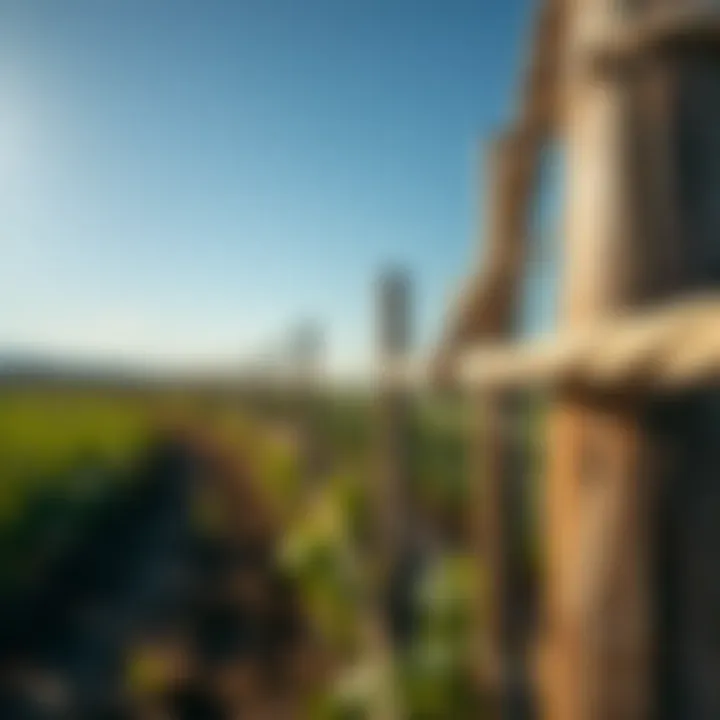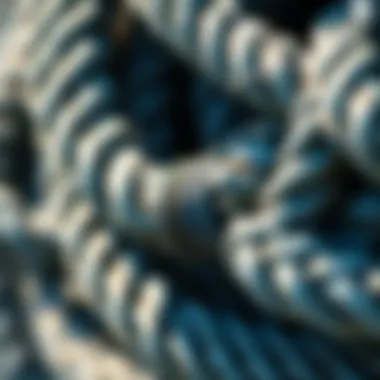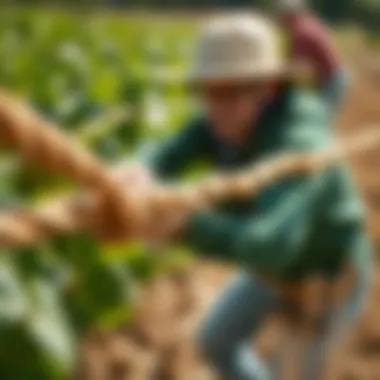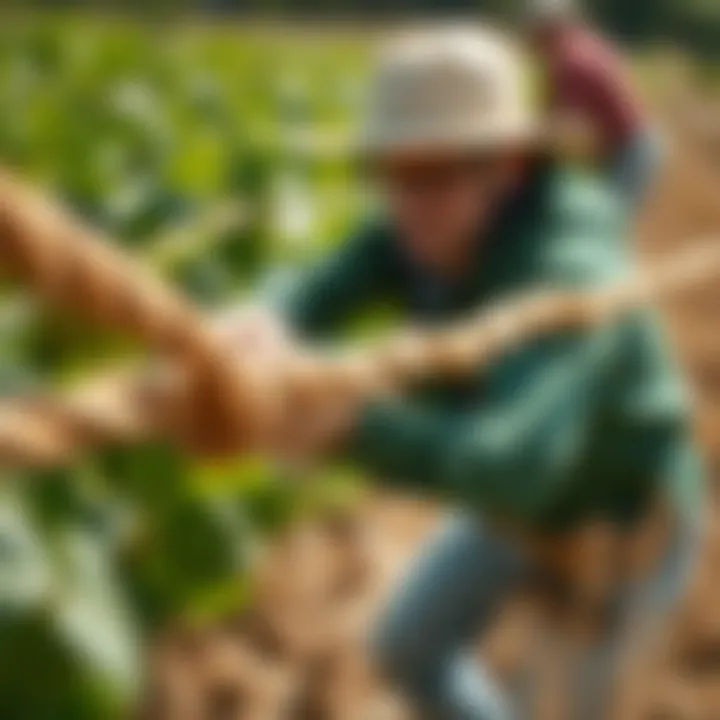Exploring Zareba Poly Rope: Features and Best Practices


Key Insights
Overview of the Topic
In the landscape of modern agriculture, fencing solutions play a critical role, particularly in protecting crops and defining boundaries. Among the myriad options available, Zareba poly rope stands out due to its distinctive blend of durability and lightweight construction. This high-performance rope is not merely a tool, but an innovative resource designed to address the challenges faced by farmers and horticulturists alike. By harnessing its unique properties, agricultural enthusiasts can optimize their fencing systems, making it easier to manage livestock and secure young plants.
Importance in Agriculture/Horticulture/Agronomy
The significance of Zareba poly rope extends well beyond just functionality.
- Its corrosion-resistant material ensures it withstands harsh weather conditions.
- The bright color aids in visibility, which is particularly valuable in mixed crop environments.
- Additionally, its lightweight nature allows for easy handling, installation, and reconfiguration, which is a boon for gardeners who often shift their layouts.
What sets it apart from other materials, such as barbed wire or traditional fencing methods, is its versatility. Zareba poly rope can be employed in various applications, from temporary fencing setups to permanent garden borders. This adaptability not only enhances the aesthetic appeal of farm landscapes but also provides practical solutions that can lead to more efficient farming practices.
"Utilizing versatile tools like Zareba poly rope can transform traditional farming into a more adaptable and efficient practice, catering to the evolving demands of agriculture."
Sustainable Practices
Eco-Friendly Techniques
In light of growing environmental concerns, Zareba poly rope offers an eco-friendly alternative to conventional fencing materials. Most notably, it is designed to minimize waste over time due to its long lifespan. Farmers can adopt several sustainable practices when utilizing this product:
- Minimal chemical treatments: Many poly ropes are manufactured without harmful chemicals, making them less detrimental to the surrounding ecosystem.
- Lightweight: This reduces the carbon footprint during transportation and installation.
- Reusability: The durability of poly rope encourages farmers to repurpose it in different settings over the years.
Case Studies on Sustainability
Several farmers have reported significant improvements in their operations after integrating Zareba poly rope into their practices. For instance, one vineyard in California transitioned from traditional wire fencing to poly rope. The result was not only cost savings due to less hardware required but also a notable decrease in injury among vineyard workers who had previously handled sharp barbed wire.
Another case involves a community garden that implemented Zareba poly rope as a temporary barrier. Its ease of installation allowed for flexibility in layout adjustments during planting seasons, accommodating different crop types easily.
Tools & Resources
Essential Equipment and Technologies
To maximize effectiveness while working with Zareba poly rope, certain tools are essential:
- Post Drivers: Facilitate efficient installation of fence posts.
- Rope Tensioner: Helps to maintain appropriate tension in the rope, essential for maximizing its effectiveness.
- Protective Gloves: Ensure safe handling, as while it is lightweight, sharp edges from posts may cause minor injuries.
Recommended Books and Readings
For further insights into fencing solutions and sustainable practices, the following resources are beneficial:
- "The Organic Farmer's Business Handbook" offers insight on sustainable farm practices including fencing.
- Online forums like Reddit have discussions from seasoned farmers sharing experiences on various materials and techniques.
- Explore articles and papers available on edu domains that delve into agricultural advancements and material innovations.
Preamble to Zareba Poly Rope
Zareba poly rope has carved out a niche in modern agricultural practices, becoming a dependable choice for farmers and gardeners alike. The benefits are manifold, but what makes this poly rope stand out? It's a blend of versatility and resilience, offering a range of applications that go beyond traditional fencing options. Understanding how this material fits within the agricultural landscape can greatly enhance the efficiency of farming operations, making it worthwhile to explore the features and best practices associated with its use.
Understanding Poly Rope
Poly rope is an intricate blend of synthetic fibers designed to maintain strength and flexibility. Its lightweight nature makes it an easy-to-handle solution, which is particularly beneficial in rural settings where heavy-duty materials might not be accessible. Made primarily from polyethylene, Zareba poly rope boasts a tensile strength that doesn't compromise on durability. It is resistant to rot and won’t absorb moisture, which is a significant advantage in areas with high humidity or frequent rain.
The composition is a key element to consider: poly ropes have a smooth, consistent surface that reduces friction. This feature allows for simple unwinding and repositioning without the risk of tangles or kinks that can slow down work processes. For farmers managing livestock or planting arrangements, this means smooth operation when adjusting fencing or trellising.
Significance in Agriculture
When it comes to agriculture, Zareba poly rope isn't just another tool in the shed; it's an essential component that can make or break the daily routines of farm life. Its application spans numerous areas, from fencing to supporting plants in gardens.
- Livestock Safety: Poly rope fencing provides a visible boundary that keeps animals contained, reducing the chance of escapes while also safeguarding crops from being trampled.
- Plant Support: In community gardens or backyard setups, using poly rope for trellising offers strong support for climbing plants, resulting in healthier growth and better yields.
- Temporary Dividers: During planting seasons, this rope can serve as a temporary barrier to protect new crops from wandering animals, allowing them to establish themselves properly.
"The use of Zareba poly rope has revolutionized the way farmers approach fencing and crop management; it’s a game changer."
Material Properties of Zareba Poly Rope
The material properties of Zareba poly rope form the backbone of its functionality and effectiveness in various agricultural applications. Understanding these characteristics is crucial, as they directly impact its usability, durability, and suitability for specific tasks on the farm.
Composition and Durability


Zareba poly rope is primarily composed of high-tenacity polypropylene, which is engineered for strength and resilience. This synthetic material provides significant tensile strength, allowing the rope to withstand heavy loads without fraying or breaking. Additionally, the fibers are designed to resist abrasion, making them suitable for rough environments often found in agricultural settings. Farmers can depend on this rope for tasks ranging from fencing livestock to supporting heavy plants without fearing that it will succumb to everyday wear and tear.
Durability Characteristics:
- Wear Resistance: The construction of Zareba poly rope inherently offers considerable resistance against physical handling and environmental factors. It can be dragged through rough terrains, making it ideal for outdoor use.
- Longevity: When well-maintained, Zareba poly rope can last for many seasons, making it a wise investment for farmers looking to minimize replacement costs.
UV Resistance and Weathering
One of the standout features of Zareba poly rope is its excellent UV resistance. Constant exposure to sunlight can degrade many materials, but not with this rope. It boasts additives that counteract the harmful effects of ultraviolet radiation, ensuring that it maintains its structural integrity over time. This property is essential for agricultural use, where the rope may be out in the elements for extended periods.
Key Benefits of UV Resistance:
- Stays Stronger for Longer: The resistance to UV rays helps in preserving the rope’s color and strength, reducing the chance of it becoming brittle over time.
- Reduced Frequency of Replacement: By improving longevity, it means less hassle for farmers and less waste in landfills.
Flexibility and Handling
Another noteworthy aspect of Zareba poly rope is its flexibility. Unlike many traditional wire or metal options, this poly rope can be easily manipulated, allowing for convenient installation and adjustment in various applications. Farmers appreciate being able to tie knots, create loops, and secure items without excessive effort.
Handling Advantages:
- Easy to Work With: This flexibility allows for quick setups—important when you're racing against the weather or dealing with an unexpected situation on the farm.
- Lightweight Nature: Compared to alternatives, Zareba poly rope is light, which further enhances its ease of use without compromising strength.
In summary, the material properties of Zareba poly rope, including its composition, UV resistance, and flexibility, all contribute to its remarkable adaptability in agricultural settings. Whether used for fencing, gardening, or other utility needs, understanding these characteristics can help farmers make informed choices that suit their agricultural practices.
Applications of Zareba Poly Rope in Agriculture
Zareba poly rope has carved out a noteworthy niche in the agricultural domain, especially for those managing livestock, gardens, or crop spaces. Its versatility is not just a talking point; it translates into practical benefits that can significantly enhance how agricultural tasks are approached. Understanding these applications is critical for farmers and gardeners who aim to optimize their efforts. The rope's capacity to serve multiple roles speaks to its design and the materials used in its construction, making it a valuable asset in any farming toolkit.
Fencing for Livestock
One of the primary uses of Zareba poly rope is for fencing livestock, an essential consideration for farmers who need to keep their animals safe and secure. Traditional fencing can often be a hefty investment, both in terms of materials and labor. On the other hand, poly rope offers a flexible and cost-effective solution.
Its lightweight nature makes it straightforward to transport, while the colorful visibility aids in demarcating boundaries clearly, which is especially useful in hilly or wooded areas where sightlines may be obstructed. Additionally, the absence of sharp edges means animals are less likely to injure themselves compared to barbed wire or other metal options. This quality not only prioritizes the well-being of the animals but also reduces veterinary costs in the long run.
Common practices when using poly rope for fencing involve:
- Correct tensioning: Ensure that the rope is taut to prevent it from sagging which can lead to escapes.
- Regular inspections: Check for fraying or signs of wear to maintain structural integrity.
- Use of insulators: This prevents electrical energy loss if the rope is electrified, ensuring efficacy.
Garden Support and Trellising
Zareba poly rope also excels in garden applications, particularly for supporting climbing plants and creating trellises. Its durability and strength allow it to support various plants effectively, from tomatoes to cucumbers and beyond. With the right installation, it can withstand the weight of heavy fruits and vines, ensuring that your garden flourishes and produces.
How to utilize poly rope for a trellis:
- Select your plants: Determine which plants require vertical support.
- Choose an appropriate location: Ensure the area receives suitable sunlight and has appropriate drainage.
- Install sturdy stakes: Place stakes at each end and a few places in between for adequate support.
- Tie the rope: Use the Zareba poly rope to create horizontal lines, tying them securely to each stake.
Remember to adjust the height of the rope as plants grow. This not only provides support but also improves air circulation around the plants, which can help reduce disease.
Temporary Barriers for Crops
Another notable application of Zareba poly rope is its use as temporary barriers for crops. Farmers often face challenges with pests and animals that can damage young crops. Installing a quick and adjustable barrier can shield these vulnerable plants and support their initial growth phases.
Using poly rope allows for flexibility; farmers can position barriers as needed without significant modifications. This adaptability is a game changer during peak seasons when quick deployment is essential.
To effectively set up temporary barriers:
- Identify high-risk areas: Where animals or pests frequently breach.
- Set up markers: Use flags or other materials to denote the area before installing the rope.
- Tie off firmly: Make sure the rope is securely fastened to posts or trees to prevent the barrier from collapsing.
Incorporating Zareba poly rope into agricultural strategies offers numerous advantages, from protecting livestock to supporting crops, and even deterring pests. Its lightweight, durable design makes it suitable for various scenarios, ensuring it remains a staple in modern agricultural practices.
Comparative Analysis
In understanding Zareba poly rope, it's vital to compare it with traditional fencing methods. This analysis is not merely a matter of preference but speaks to the evolving needs of modern agriculture. Farmers and gardening enthusiasts must consider key aspects such as durability, cost-effectiveness, and environmental implications when deciding on the fencing solution best suited for their needs. The right fencing can make the difference between thriving crops and costly losses.
Zareba Poly Rope vs. Traditional Fencing Methods
When you stack Zareba poly rope against traditional fencing methods like barbed wire or wooden fencing, several defining features come into play. For one, poly rope is lightweight, making it easier to handle and install. This can save time and labor costs, which often add up in farming operations.
Moreover, poly rope can be far more adaptable. It can be easily tensioned, allowing for flexible configurations that traditional methods rarely provide. In a nutshell:


- Material Flexibility: Unlike rigid wooden or metal fences, poly rope can bend and adjust, making it suitable for different terrains.
- Cost Savings: Most farmers find that Zareba poly rope has a lower upfront cost compared to constructing wooden fencing or installing metallic barriers.
- Aesthetic Appeal: This rope can blend more naturally into farm landscapes, especially when compared to stark metal fences.
However, it’s also essential to mention some drawbacks. In areas where livestock are prone to aggressive behaviors, traditional fencing might provide better physical resistance. Some farmers might see poly rope as too permissive, leaving them worried about livestock escaping.
Cost Efficiency and Longevity
Let's face it; running a farm means keeping an eye on the budget. Zareba poly rope tends to shine brightly in this area. Aside from the low initial cost, it offers impressive longevity. A good quality poly rope can last several years with proper care. When placed side by side with wooden or metal options, the long-term savings become apparent.
- Durable Lifespan: With resistance to rotting and rusting, Zareba poly rope outlasts many wooden alternatives, which need frequent replacement.
- Maintenance Cost: Traditional fences require ongoing maintenance, from painting wooden slats to untangling barbed wire. Poly rope cuts down these costs significantly, as it needs minimal maintenance compared to other fencing types.
- Replacement Ease: When a section of poly rope gets damaged, it’s a straightforward process to replace just that segment rather than having to repair an entire fence line.
Environmental Impact Considerations
When it comes to sustainable farming, environmental impact is a concern that cannot be overlooked. Zareba poly rope is generally considered to be a more eco-friendly option than its counterparts. Many traditional fencing solutions involve chemical treatments and non-biodegradable materials, which can negatively affect soil and surrounding ecosystems.
In contrast:
- Recyclability: Poly materials can often be recycled, thereby reducing waste in landfills compared to wooden or metal fences that may end up discarded without reuse.
- Minimal Footprint: As a product designed for utility, poly rope takes less natural resource input in production than other fencing materials, contributing to a lighter carbon footprint.
- Effect on Wildlife: The softer nature of poly rope can be less hazardous to wildlife, reducing the chances of injury or fatal entanglements that often occur with traditional barbed or woven fences.
Through this comparative analysis, one can gain deeper insight into how technological advancements in materials can lead to better agricultural strategies.
Installation Techniques for Zareba Poly Rope
When it comes to setting up Zareba poly rope, nailing down the correct installation techniques is crucial for ensuring the longevity and effectiveness of your fencing. The right approach not only safeguards your investment but also enhances the overall performance of the rope in a variety of agricultural settings. Key benefits of understanding proper installation techniques include improved durability, optimal use of resources, and minimizing the risk of future adjustments or repairs.
Tools and Equipment Needed
Before diving into installation, it’s wise to gather the necessary tools and equipment to streamline the process. Here’s a list to help you prepare:
- Zareba Poly Rope - Ensure you have the correct length and type for your specific needs.
- Fencing Posts - Wooden or metal posts can provide sturdy support for the rope.
- Post Hole Digger - Helps create appropriate holes for the posts.
- Level - Important for ensuring that your posts are straight and in alignment.
- Wire Cutters - Useful for cutting any wire supports if needed.
- Staple Gun or Clips - For securing the rope to the posts.
- Hammer or Mallet - To assist in driving the posts into the ground.
- Measuring Tape - For accurate spacing between posts.
Step-by-Step Installation Process
Now that you have your tools, let’s break down the installation process into manageable steps. Here’s how to get the job done effectively:
- Choosing the Location: Select a location that is free from obstacles like large rocks or dense brush. This reduces potential damage to the rope during installation and use.
- Setting the Posts: Use the post hole digger to create holes for your fencing posts. The distance between these posts should usually be around 10 to 12 feet apart, but this can vary depending on specific fencing needs.
- Placing and Securing Posts: Insert the posts into the holes and use the level to ensure they are straight. Backfill with soil or concrete to secure them firmly in place.
- Measuring the Rope: Cut the Zareba poly rope to the desired length. Ensure you have a little extra length to account for knots or securing methods.
- Threading the Rope: Attach one end of the rope to the first post using staples or clips; ensure it's tightly secured.
- Running the Rope: Stretch the rope across to the next post, ensuring it is taut. Repeat this process for the remaining posts.
- Final Securing: Secure the rope at each post, making sure it’s not too tight to allow for some give, especially in windy conditions.
Tips for Secure Fencing
To maximize the effectiveness of your setup, consider the following tips:
- Check Tension Regularly: It’s good practice to periodically check the tension of the rope, especially after heavy winds or snowfall.
- Avoid Sharp Edges: Ensure there are no sharp edges that could fray or damage the poly rope over time.
- Use Insulators: If needed, you can use insulators to prevent the rope from rubbing against the posts, which can lead to premature wear.
- Routine Inspections: Regularly inspect your fencing for any signs of wear or damage. The sooner you can address these issues, the easier they will be to fix.
Having a solid installation technique not only saves you time but also money in the long run, as it minimizes maintenance and repair costs.
By mastering these installation techniques, you’ll set up a Zareba poly rope fencing system that stands the test of time, allowing you to focus on what really matters: your crops and livestock.
For further reading on fencing techniques, check out Wikipedia on Fencing Methods.
Maintenance of Zareba Poly Rope
Maintaining Zareba Poly Rope is crucial for maximizing its effectiveness and longevity in any agricultural setting. Over time, exposure to varying weather conditions, livestock interaction, and natural wear can diminish the rope's strength and reliability. Regular maintenance not only enhances the lifespan of the rope but also ensures that it performs optimally in its intended applications. Farmers and gardening enthusiasts should pay close attention to proper inspection, cleaning, and storage practices to keep their poly rope in excellent condition.
Inspection and Repair Protocols
Inspection is the first line of defense against deteriorating conditions. Every few months—or after severe weather events—it’s wise to thoroughly examine the rope for any signs of damage. Look out for frays, knots, or irregularities that could signal wear and tear. Here are some recommended steps for inspecting and repairing Zareba Poly Rope:
- Visual Assessment: Check for any visible damage. Look for areas that seem weaker or excessively frayed.
- Functional Testing: If the rope is installed, ensure it still holds tension and is secure. Tugging on sections gently can help check integrity without causing strain.
- Repair Techniques: For minor frays, using a lighter to carefully melt the ends can prevent further unraveling. In cases of significant damage, replacing the compromised section might be necessary to maintain safety.
Tip: Always keep a spare length of Zareba Poly Rope on hand for quick replacements during inspections.
Cleaning and Care Recommendations
Cleaning Zareba Poly Rope is often overlooked, yet it greatly contributes to its durability. Dirt and grime can lead to the material breaking down faster. Here are some simple cleaning steps that can keep your rope looking fresh and functional:
- Remove Debris: Shake off any loose dirt or weeds caught in the rope. You can use a soft scrub brush to help.
- Use a Mild Detergent: A bucket of warm water mixed with a mild soap can work wonders. Soak the rope for a bit, then scrub gently.
- Rinse Thoroughly: Ensure that all soap is rinsed off to prevent any residues that might attract dirt.
- Dry Completely: Hang the rope out to dry fully before storage. This is vital to prevent mold or mildew buildup.


Storage Guidelines for Longevity
How and where you store your Zareba Poly Rope can affect its lifespan significantly. Proper storage can keep the rope ready for use whenever needed:
- Keep it Cool and Dry: Avoid exposing the rope to direct sunlight for long periods during storage as UV rays can weaken the fibers over time.
- Use a Dry Container: Store the rope in a dry container or shed to protect it from excessive moisture. Moist conditions can cause the rope to rot.
- Avoid Tight Coiling: Instead of tightly coiling the rope, loosely wrap it around a reel or a peg. This prevents kinking and allows for easier unrolling when needed.
Ultimately, the key to maintaining Zareba Poly Rope is diligence in inspection, thoughtful cleaning practices, and mindful storage techniques. This not only preserves your investment but also ensures that you have the best tool at hand for all your agricultural fencing needs.
Challenges and Limitations
While Zareba poly rope presents a host of advantages for agricultural applications, it is crucial for farmers and gardening enthusiasts to be aware of its challenges and limitations. Understanding these aspects not only helps in proper utilization but also assists in making informed decisions that align with specific farming requirements. Addressing potential hurdles can boost the longevity and efficiency of poly rope, ultimately benefiting the agricultural undertaking.
Understanding Environmental Limitations
One of the first factors to consider is how environment affects the performance of Zareba poly rope. It’s a well-known fact that extreme conditions can change the behavior of materials. High temperatures, humidity, or prolonged exposure to UV rays can result in degradation over time. In regions with high levels of rain, for example, moisture can seep into the fibers, leading to rot and hastened wear. This is especially critical in areas where the rope is expected to endure heavy usage.
"Weather can be a fickle friend; best to prepare for the worst while hoping for the best."
To mitigate these risks, consider placing poly rope in areas that experience less harsh weather or utilize additional protective measures, such as canopies or shade cloths to shield against direct sunlight. While poly rope is designed to resist some environmental stressors, being proactive can enhance its durability and performance significantly.
Physical Limitations in Dense Areas
Another challenge that arises pertains to physical limitations in dense or cluttered areas. Dense vegetation or crowded spaces may hinder the effective use of Zareba poly rope. The flexibility that makes it a versatile tool can become a disadvantage when navigating through thorny branches or dense growth. In these situations, the rope can become tangled or snagged, making installation and maintenance more difficult.
Farmers should gauge the layout carefully, ensuring that there is ample space for the rope to function without interference. Think about clearing areas of thick brush prior to installation or considering alternate fencing methods in particularly challenging spots. If dense vegetation is unavoidable, the use of barrier materials may be warranted to minimize those physical challenges.
Innovations in Poly Rope Technology
Innovations in poly rope technology have been shaping how agricultural practices are implemented, particularly in fencing solutions. As technology evolves, so too does the ability to create materials and systems that are more effective and adaptable to the needs of modern farming. The focus here is not just on physical attributes of the poly rope itself, but also on how these innovations influence the way that farmers and horticulturists can utilize these tools in their operations.
The relevance of these innovations cannot be overstated. From the introduction of lighter yet stronger materials to advanced manufacturing techniques, the capabilities of poly ropes have expanded. This is particularly important for farmers who often face the dual challenge of effective fencing for livestock while ensuring cost efficiency.
Emerging Materials and Techniques
The quest for better and more durable materials has paved the way for several emerging innovations in poly rope. For instance, manufacturers are experimenting with blends of traditional poly materials and newer synthetic fibers. These combinations result in ropes that are not only lightweight but also exhibit superior strength and resistance to wear and tear.
Moreover, incorporating antimicrobial treatments into the rope fibers can help in reducing mold growth, thereby enhancing durability in humid or wet conditions. This is especially beneficial for regions that face unpredictable weather patterns. The introduction of reflective elements in poly rope can also serve a dual purpose: improving visibility for farmers while deterring animals from approaching the fence, which can be quite useful in keeping livestock secure.
Exploration of Smart Fencing Solutions
In the digital age, even traditional concepts like fencing are being reimagined through technology. Smart fencing solutions incorporated with Zareba poly rope depict a forward-thinking approach to securing agricultural lands. These solutions can include sensors embedded in the rope or along the fencing, designed to alert farmers to breaches or unauthorized access.
The integration of smart technology enables remote monitoring through smartphone applications, giving farmers the ability to oversee the integrity of their fencing systems from virtually anywhere. This level of oversight helps reduce losses from wandering livestock or wildlife that might disrupt crops. Operational efficiency increases substantially when so much data becomes easily accessible, ensuring that farmers can make informed decisions quickly.
"The safety of livestock and crops directly influences the bottom line of a farm operation; innovations in fencing technology ensure these assets are well-protected."
As a result, while traditional poly rope remains a crucial element for farming practices, the continuous innovations in materials and technology are creating opportunities that can optimize agricultural practices, increase yields, and ultimately enhance sustainability in farming. Adapting to these innovations is not just smart—it's essential for the modern farmer.
The End
The conclusion of this article is where we tie together the insights and discussions surrounding Zareba poly rope. It's not simply about summarizing what's been laid out, but more about underscoring the significance this product holds in modern agricultural practices. This versatile tool serves various functions in farming, from securing livestock to supporting plant growth. Each aspect we've discussed emphasizes not just the material properties or installation techniques, but the practical benefits farmers and gardening enthusiasts can gain from employing Zareba poly rope effectively.
When considering the benefits, one could mention its strong resistance to environmental stresses, which reduces the financial burden on farmers by lessening the need for frequent replacements. Furthermore, as weather patterns change and new agricultural challenges arise, the ability to adapt using this product is crucial.
Additionally, understanding future applications and innovations in this field will pave the way for even more efficient usage, enhancing both productivity and sustainability in agriculture.
"Integrating modern tools like Zareba poly rope is essential for farmers aiming to optimize their yields while managing resources wisely."
Another critical point in our conclusion is the role of Zareba poly rope in environmental consciousness. By utilizing durable materials and efficient fencing solutions, farmers can lower their carbon footprints and promote ecosystems that thrive without compromising on productivity.
In this narrative, the takeaway isn't only on features and applications but how Zareba poly rope is a significant player in the agriculture sector's move towards smarter, more sustainable practices. Thus, we encourage our readers to consider this product as a reliable and adaptable option for their agricultural needs.
Summary of Key Takeaways
- Versatility: Zareba poly rope's applications extend across various agricultural needs, including fencing, support mechanisms, and barriers for crops.
- Durability: The material's robustness against weather and UV exposure ensures less frequent replacements, making it cost-effective for long-term use.
- Installation Flexibility: Simple tools and techniques allow for easy setup, which can be adapted based on the specific requirements of your land or crops.
- Environmental Benefits: Utilizing Zareba poly rope aligns with sustainable practices, aiding in reducing waste and promoting efficient farming methods.
Future Perspectives on Zareba Poly Rope Usage
As agricultural technology continues to advance, the future of Zareba poly rope looks promising. Innovations in material science might lead to even tougher and lighter ropes, pushing the boundaries of what farmers can achieve.
Imagine a scenario where smart sensors embedded in the rope alert farmers to wear and tear or environmental changes. This real-time feedback could not only extend the lifespan of the rope but enhance overall efficiency in farming practices.
Furthermore, with the increasing focus on sustainability, there's a likelihood that new formulations of poly rope will emerge, further minimizing the environmental impact. This innovation could make Zareba products even more appealing as farmers seek to balance productivity with ecological responsibility.







